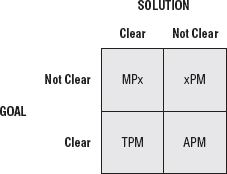Understanding the Complexity/Uncertainty Domain of Projects
The four-quadrant project landscape (Figure 9-1) is used first to categorize the project to a quadrant, and within that quadrant to select a best-fit PMLC model. But even having made that categorization and selected a best-fit PMLC model based on goal and solution clarity, you are not quite finished. Contemporary projects have become more uncertain, and along with this increased uncertainty is increased complexity. Uncertainty is the result of changing market conditions that require high-speed and high-change responses to produce a solution in order to be competitive. Complexity is the result of a solution that has eluded detection and will be difficult to find. That imposes a challenge on the project manager to be able to respond appropriately. Hence the complexity of project management increases as well. Uncertainty and complexity are positively correlated.
Figure 9-1: The Project Landscape

As you move through the quadrants from clarity to lack of clarity and from low uncertainty to high uncertainty, the project management processes you use must track with the needs of the project. Here's a general word of advice: As you move through the quadrants, remember that “lots is bad, less is better, and least is best.” In other words, don't burden yourself and your team with needless planning and documentation that will just ...
Get Effective Project Management: Traditional, Agile, Extreme, Sixth Edition now with the O’Reilly learning platform.
O’Reilly members experience books, live events, courses curated by job role, and more from O’Reilly and nearly 200 top publishers.

